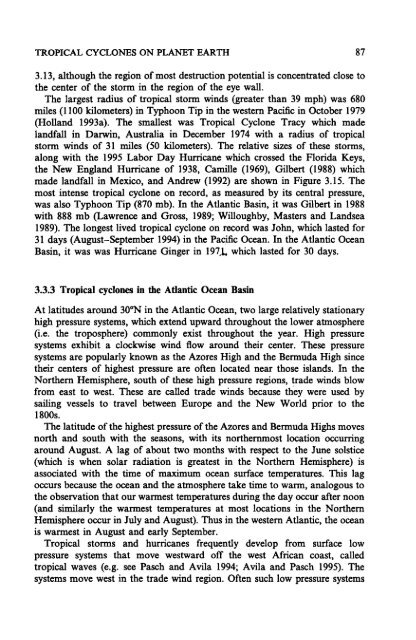Hurricanes: Their Nature and Impacts on Society - Climate Science ...
Hurricanes: Their Nature and Impacts on Society - Climate Science ...
Hurricanes: Their Nature and Impacts on Society - Climate Science ...
Create successful ePaper yourself
Turn your PDF publications into a flip-book with our unique Google optimized e-Paper software.
TROPICAL CYCLONES ON PLANET EARTH<br />
3.13, although the regi<strong>on</strong> of most destructi<strong>on</strong> potential is c<strong>on</strong>centrated close to<br />
the center of the storm in the regi<strong>on</strong> of the eye wall.<br />
The largest radius of tropical storm winds (greater than 39 mph) was 680<br />
miles (1100 kilometers) in Typho<strong>on</strong> Tip in the western Pacific in October 1979<br />
(Holl<str<strong>on</strong>g>and</str<strong>on</strong>g> 1993a). The smallest was Tropical Cycl<strong>on</strong>e Tracy which made<br />
l<str<strong>on</strong>g>and</str<strong>on</strong>g>fall in Darwin, Australia in December 1974 with a radius of tropical<br />
storm winds of 31 miles (50 kilometers). The relative sizes of these storms,<br />
al<strong>on</strong>g with the 1995 Labor Day Hurricane which crossed the Florida Keys,<br />
the New Engl<str<strong>on</strong>g>and</str<strong>on</strong>g> Hurricane of 1938, Camille (1969), Gilbert (1988) which<br />
made l<str<strong>on</strong>g>and</str<strong>on</strong>g>fall in Mexico, <str<strong>on</strong>g>and</str<strong>on</strong>g> Andrew (1992) are shown in Figure 3.15. The<br />
most intense tropical cycl<strong>on</strong>e <strong>on</strong> record, as measured by its central pressure,<br />
was also Typho<strong>on</strong> Tip (870 mb). In the Atlantic Basin, it was Gilbert in 1988<br />
with 888 mb (Lawrence <str<strong>on</strong>g>and</str<strong>on</strong>g> Gross, 1989; Willoughby, Masters <str<strong>on</strong>g>and</str<strong>on</strong>g> L<str<strong>on</strong>g>and</str<strong>on</strong>g>sea<br />
1989). The l<strong>on</strong>gest lived tropical cycl<strong>on</strong>e <strong>on</strong> record was John, which lasted for<br />
31 days (August-September 1994) in the Pa~c Ocean. In the Atlantic Ocean<br />
Basin, it was was Hurricane Ginger in 197.1. which lasted for 30 days.<br />
3.3.3 Tropical cycl<strong>on</strong>es in the Atlantic Ocean Basin<br />
At latitudes around 30oN in the Atlantic Ocean, two large relatively stati<strong>on</strong>ary<br />
high pressure systems, which extend upward throughout the lower atmosphere<br />
(i.e. the troposphere) comm<strong>on</strong>ly exist throughout the year. High pressure<br />
systems exhibit a clockwise wind flow around their center. These pressure<br />
systems are popularly known as the Azores High <str<strong>on</strong>g>and</str<strong>on</strong>g> the Bermuda High since<br />
their centers of highest pressure are often located near those isl<str<strong>on</strong>g>and</str<strong>on</strong>g>s. In the<br />
Northern Hemisphere, south of these high pressure regi<strong>on</strong>s, trade winds blow<br />
from east to west. These are called trade winds because they were used by<br />
sailing vessels to travel between Europe <str<strong>on</strong>g>and</str<strong>on</strong>g> the New World prior to the<br />
1800s.<br />
The latitude of the highest pressure of the Azores <str<strong>on</strong>g>and</str<strong>on</strong>g> Bermuda Highs moves<br />
north <str<strong>on</strong>g>and</str<strong>on</strong>g> south with the seas<strong>on</strong>s, with its northernmost locati<strong>on</strong> ocCurring<br />
around August. A lag of about two m<strong>on</strong>ths with respect to the June solstice<br />
(which is when solar radiati<strong>on</strong> is greatest in the Northern Hemisphere) is<br />
associated with the time of maximum ocean surface temperatures. This lag<br />
occurs because the ocean <str<strong>on</strong>g>and</str<strong>on</strong>g> the atmosphere take time to warm, analogous to<br />
the observati<strong>on</strong> that our warmest temperatures during the day occur after no<strong>on</strong><br />
(<str<strong>on</strong>g>and</str<strong>on</strong>g> similarly the warmest temperatures at most locati<strong>on</strong>s in the Northern<br />
Hemisphere occur in July <str<strong>on</strong>g>and</str<strong>on</strong>g> August). Thus in the western Atlantic, the ocean<br />
is warmest in August <str<strong>on</strong>g>and</str<strong>on</strong>g> early September.<br />
Tropical storms <str<strong>on</strong>g>and</str<strong>on</strong>g> hurricanes frequently develop from surface low<br />
pressure systems that move westward off the west Mrican coast, called<br />
tropical waves (e.g. see Pasch <str<strong>on</strong>g>and</str<strong>on</strong>g> Avila 1994; Avila <str<strong>on</strong>g>and</str<strong>on</strong>g> Pasch 1995). The<br />
systems move west in the trade wind regi<strong>on</strong>. Often such low pressure systems<br />
87














